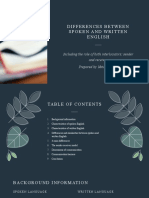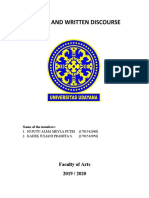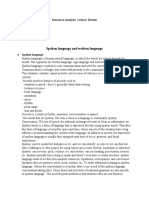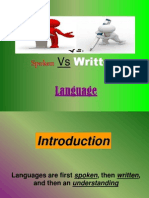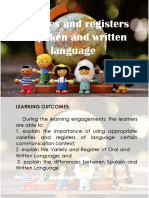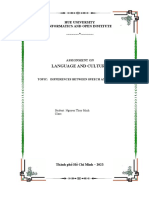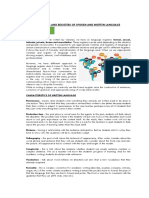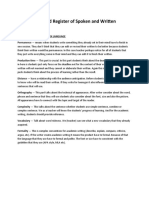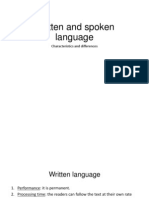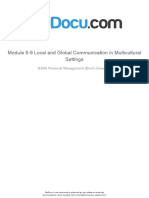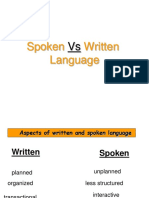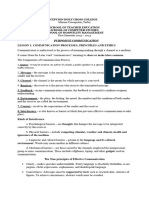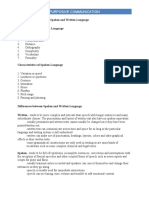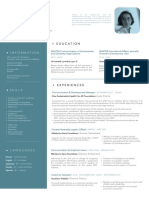Unit 4: Local and Global Communication in Multicultural Settings
Lesson 1: Varieties and Registers of Spoken and Written Language
Learning Outcomes
By the end of this lesson, learners should be able to:
1. Recognize the differences between various forms and levels (registers) of spoken and
written language.
2. Apply either spoken or written language effectively to match different communication
scenarios.
Introduction
Grasping the concepts of language varieties and registers is essential for effective
communication in both local and international settings. Language variety refers to forms or
dialects that change with cultural or regional contexts, while register deals with formality
levels in language use. Selecting the right register conveys respect, professionalism, and
awareness of the audience, which is especially important in multicultural settings. Spoken
interactions are usually multimodal, mixing verbal and non-verbal cues, while writing relies
on structure, grammar, and vocabulary to achieve clarity and formality.
Deepening Your Understanding
Why Distinguishing Written from Spoken Communication Matters
Knowing the differences between spoken and written communication is crucial for
engaging meaningfully. Unlike written content, which can be re-read, spoken language
needs to be clear from the outset, using clear pronunciation, pauses, and emphasis. Crystal
(2006) highlights that spoken language is “time-bound, dynamic, and transient,” whereas
written language is “space-bound, static, and permanent,” emphasizing that different modes
need unique strategies to meet communication goals.
The article, “Spoken and Written Language as Medium of Communication: A Self-reflection,”
also points out that the lasting nature of written language allows for complex expressions,
while spoken language’s fleeting nature often calls for simplicity and adaptability based on
audience feedback.
Comparing Written and Spoken Communication
Here are some distinct differences:
1. Social vs. Private: Speaking often occurs in social contexts, while writing can be a more
private activity.
2. Universality vs. Skill: Speaking is learned naturally, while writing generally requires
formal instruction.
3. Planning: Writing is more likely to be planned, whereas speech is often unstructured or
spontaneous.
4. Non-verbal Cues: Speech involves gestures and facial expressions, while writing relies on
�punctuation and format.
5. Permanence: Writing leaves a lasting record, while spoken language is transient.
The study 'Register Variation in Written Contact Varieties of English: A Multidimensional
Analysis' demonstrates that even within written language, registers vary according to the
audience, purpose, and context, emphasizing the importance of understanding these
differences.
Characteristics of Written Language
1. Planned: Writing usually requires careful planning, as it often reaches an unknown
audience.
2. Organized: Written texts should present ideas in a clear, logical structure.
3. Durable: Writing serves as a permanent record, preserving information over time.
Characteristics of Spoken Language
1. Variation in Speed and Volume: Changes in speed and volume can convey emphasis and
emotion.
2. Gestures and Facial Expressions: Non-verbal cues play a big role in spoken language.
3. Intonation and Rhythm: Variations in pitch and rhythm help express meaning.
4. Pausing and Phrasing: Pauses make it easier for listeners to understand and follow the
speaker.
According to Lingua journal, speech relies on 'phonic substance' and instant feedback,
making it flexible but fleeting.
Principles of Effective Oral Communication
1. Clear Purpose: Knowing the purpose guides language choices and delivery style.
2. Complete Message: Provide full information with necessary details.
3. Conciseness: Keep it brief to maintain audience interest.
4. Natural Delivery: Use gestures naturally to emphasize important points without
distraction.
5. Timely Feedback: Effective feedback is quick and specific, making communication more
effective.
Principles of Effective Written Communication: The 7 Cs
1. Be Clear: Make sure the message’s purpose is clear.
2. Be Concise: Stick to the main point and avoid unnecessary details.
3. Be Concrete: Back up claims with specific facts.
4. Be Correct: Check for grammar accuracy and review the text if needed.
5. Be Coherent: Organize ideas logically.
6. Be Complete: Include all necessary information.
7. Be Courteous: Use a respectful tone to avoid misinterpretation or negativity.
Conclusion
Understanding varieties and registers in communication is essential in a multicultural
world. Both written and spoken language have unique qualities, and knowing when to use a
�particular register or form of language improves communication. By adapting language to
fit the social, professional, or formal context, communicators can bridge cultural and
linguistic differences, encouraging respect and understanding in a globalized world.






